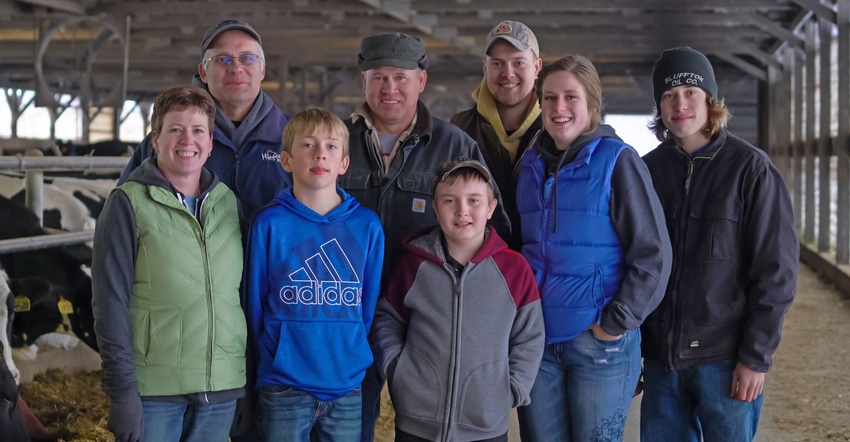
From its start in 1994 through the pandemic challenges of 2020, tenacity and thinking outside the box continue to guide the Spadgenske family dairy farm in its pursuit of producing high-quality milk.
In recognition of their efforts, the Minnesota Milk Producers Association gave its 2020 Producer of the Year award to Spadgenske Dairy of Menahga, Minn., during its Dec. 2 virtual annual meeting.
The Spadgenske farm includes twin brothers Mike and Mark Spadgenske, and Mark’s wife Kristine. Mark and Kristine have four children — Ryan, Kate, Adam and Seth — and Mike has a son, John. Ryan, who has a dairy management degree from Ridgewater College and is married to Jen, works full time on the farm.
“The Spadgenske family exemplifies the resiliency we’ve been seeing in Minnesota dairies. They manage their risk well, focus on their strengths and thoroughly evaluate big decisions amongst other possibilities,” said Lucas Sjostrom, MMPA executive director. “By being diversified and involved in their community, they’re a great example of Minnesota dairy farming in 2020.”
Dairy started from scratch
The Spadgenskes started their dairy from scratch in 1994 with a dream, a rented barn and a tractor. They talked with several bankers before one in Staples agreed to approve their loan request so they could purchase 60 cows.
“To this day, we have appreciation that he took a chance on us,” Kristine said.
The family now milks 350 cows, raises 400 acres of corn for silage and 1,000 acres of hay for haylage and cash crop round bales, and employs four full-time workers.
“Learning from the successes and failures of the past and building for the future is the motto of everyday life on the farm,” Kristine said. “We are not afraid to think outside the box and try something new.”
As every farmer knows, what works on one dairy might or might not work on another. At Spadgenske Dairy, the family aligns its management practices to get results with its facilities and herd nutrition program. The Spadgenskes run counter to the usual advice of not overloading the barn with cow numbers and adding cheap byproducts to their milking total mixed ration.
In 2001, the Spadgenskes moved from their rented farm to their current location. Here, they built a 240-stall slatted-floor barn and renovated an old hip-roof barn to contain a double-13 parallel milking parlor, milk house and office. Mike designed and built the parlor, which had to fit the footprint of the previous barn.
“It’s a sea of cattle [in the freestall], with 350 milking,” Kristine said. “Everyone says this isn’t good for animal health, nutrition and cow comfort, yet we make it work.” They let cows outside every day, rotating them to nearby pastures — even in winter. Stalls are fitted with mattresses and bedded with sawdust from a local pallet-making plant.
Their cows’ TMR also takes advantage of locally sourced ingredients.
“It’s a cheap formulation with byproducts,” Kristine said. It includes corn silage, hay baleage, canola meal, distillers grains and potatoes — the latter coming from a local plant that makes french fries.
“Milk production might not be as high as it could. Still, we get adequate production and milk components plus cow longevity, which is important,” she noted.
Use of sustainable practices key
The Spadgenskes also have implemented several sustainable practices over the years. They recycle milk house and parlor water two to three times before it heads for the liquid manure pit. They plant cover crops and follow a nutrient management plan. They recycle ag plastic through a Becker County program. And after completing a farm business energy audit, they did some updates, thanks to grants from the state’s Clean Energy Resource Teams program and their electric co-op. They replaced their milk vacuum pump with a variable-speed model and installed LED lighting in their calf barn and yard.
“The long-term effects, such as reduced electrical and energy costs, will be helpful,” she added.
Off the farm, the Spadgenskes are busy with church, school and community activities, plus 4-H and FFA. In nonpandemic times, they allow visitors on their farm and enjoy giving tours — especially for Menahga first-graders, who visit every fall.
Both Mark and Kristine are active in the dairy industry and participate in lobbying in Washington, D.C., and at Minnesota Milk’s Dairy Day at the Capitol. Kristine also has served on the Minnesota Dairy Promotion Council since 2008 and was a Minnesota Milk board member from 2011 to 2019.
As recipient of the Producer of the Year, the family received a scholarship toward educational programming, and a framed and matted art print.
“Our farm family is humbled to receive the award, but we don’t think we are any different from other dairy farmers,” Kristine said. “We consider it to be a true privilege to be in the dairy industry. We are thankful and proud to be a part of it.”
About the Author(s)
You May Also Like






